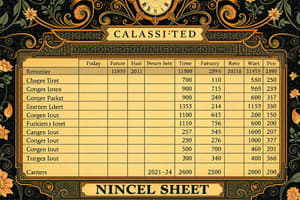Podcast
Questions and Answers
What is a Classified Balance Sheet?
What is a Classified Balance Sheet?
- A balance sheet that provides details not included in the financial statements.
- A balance sheet with only three broad account groupings.
- A balance sheet that groups asset and liability accounts into categories. (correct)
- A balance sheet that lists assets on the left and liabilities on the right.
What is a Unclassified Balance Sheet?
What is a Unclassified Balance Sheet?
- A balance sheet that lists accounts by decreasing liquidity.
- A balance sheet with only three broad account groupings: assets, liabilities, and equity. (correct)
- A balance sheet that groups asset and liability accounts into categories.
- A balance sheet listing assets on the left and liabilities on the right.
Define Current Assets.
Define Current Assets.
Resources expected to be converted to cash or consumed within the next year or operating cycle.
Give examples of Current Assets.
Give examples of Current Assets.
How are assets organized on the Classified Balance Sheet?
How are assets organized on the Classified Balance Sheet?
What does liquidity refer to?
What does liquidity refer to?
Define Non-current assets.
Define Non-current assets.
List examples of Property, Plant, and Equipment (PPE).
List examples of Property, Plant, and Equipment (PPE).
What are long-term investments?
What are long-term investments?
Define intangible assets.
Define intangible assets.
What are current liabilities?
What are current liabilities?
Provide examples of current liabilities.
Provide examples of current liabilities.
What is the current portion of a long-term liability?
What is the current portion of a long-term liability?
Classify Non-current or long-term assets.
Classify Non-current or long-term assets.
Define non-current liabilities.
Define non-current liabilities.
What is a mortgage?
What is a mortgage?
What is an Account Form Balance Sheet?
What is an Account Form Balance Sheet?
What does a Report Form Balance Sheet do?
What does a Report Form Balance Sheet do?
What are notes to the financial statements?
What are notes to the financial statements?
Define an audit.
Define an audit.
What are internal controls?
What are internal controls?
An unqualified auditor's report indicates that the financial statements are truthful.
An unqualified auditor's report indicates that the financial statements are truthful.
A qualified auditor's report indicates that the financial statements are not or may not be truthful.
A qualified auditor's report indicates that the financial statements are not or may not be truthful.
Flashcards are hidden until you start studying
Study Notes
Balance Sheet Classes
- Classified Balance Sheet: Groups assets and liabilities into categories for better organization.
- Unclassified Balance Sheet: Simplifies financials into three broad categories: assets, liabilities, and equity.
Current Assets
- Defined as resources expected to convert to cash or be consumed within a year or the operating cycle.
- Includes accounts with short-term benefits that will not convert to cash.
- Examples of Current Assets:
- Cash: physical currency, bank deposits, cheques, money orders.
- Short-term investments: cash that is reserved for short-term interest-bearing notes.
- Accounts receivable: amounts due within one year.
- Notes receivable: formal promises to pay due within one year.
- Merchandise inventory: items expected to be sold within one year.
- Prepaid expenses: costs like prepaid insurance or rent expiring within one year.
- Supplies: items expected to be consumed within the year.
Organization of Assets
- Present current assets before non-current assets on the classified balance sheet.
- Organized by decreasing liquidity.
Liquidity
- Refers to the ease of converting an asset into cash.
Non-current Assets
- Defined as assets useful for more than one year, including:
- Property, Plant, and Equipment (PPE): Tangible items used in business operations, such as land, buildings, and vehicles.
- Long-term Investments: Assets held for over one year, including notes receivable and investments in shares and bonds.
- Intangible Assets: Non-physical resources generating value like copyrights, patents, and trademarks.
Current Liabilities
- Obligations requiring payment within the next 12 months or the entity's next operating cycle.
- Listed by order of due date.
- Examples of Current Liabilities:
- Bank loans and notes payable due within 12 months.
- Accounts payable.
- Accrued liabilities like wages and interest payable.
- Unearned revenue.
- Current portion of long-term liabilities.
- Income taxes payable.
Classification of Non-current Assets and Liabilities
- Assets: Long-term investments, PPE, intangible assets.
- Liabilities: Non-current or long-term liabilities.
Non-current Liabilities
- Borrowings that do not require repayment for more than one year, such as long-term bank loans or mortgages.
Mortgage
- A specific type of liability secured by real estate.
Balance Sheet Formats
- Account Form Balance Sheet: Lists assets on the left and liabilities and owner's equity on the right.
- Report Form Balance Sheet: Presents assets first, followed by liabilities and owner's equity.
Financial Statement Disclosures
- Notes to Financial Statements: Provide relevant details not in the main statements, aiding external users in analysis.
- Audit: An external examination of a company's financial statements and internal controls.
Internal Controls
- Processes implemented by management to monitor and measure the agency's objectives, including fraud prevention.
Auditor's Reports
- Unqualified Auditor's Report: Indicates financial statements are truthful.
- Qualified Auditor's Report: Suggests the financial statements may not be entirely truthful.
Studying That Suits You
Use AI to generate personalized quizzes and flashcards to suit your learning preferences.




